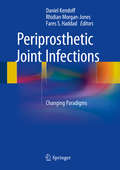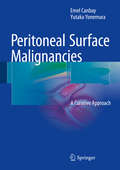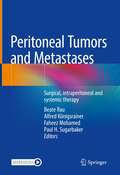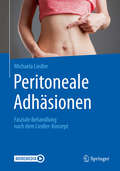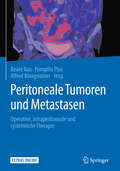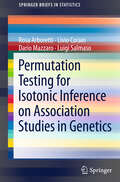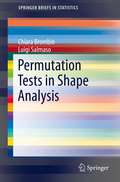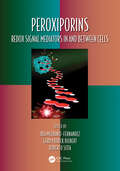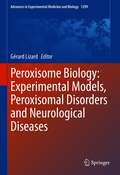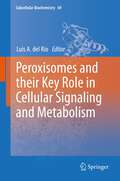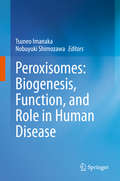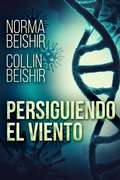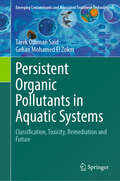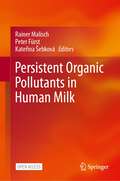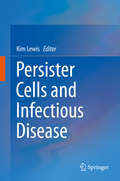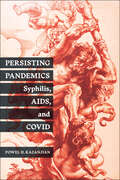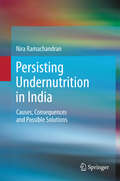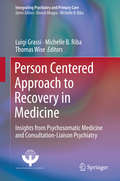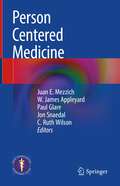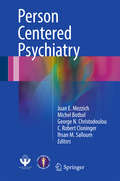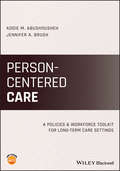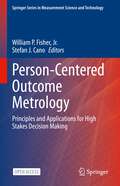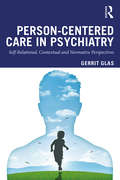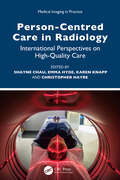- Table View
- List View
Periprosthetic Joint Infections
by Daniel Kendoff Rhidian Morgan-Jones Fares S. HaddadThis book provides a state-of-the-art,worldwide overview of treatment options available for periprosthetic joint infection(PJI). It highlights areas where tremendous progress has been made over thepast few years, looking at current evidence, projecting a way forward, anddiscussing key topics where ongoing research is needed and could potentiallyhave a huge impact on the field. In addition to familiarising readers with effectivediagnostics and treatment strategies, factors such as socioeconomicsand associated morbidity are also examined in relation to thisincreasingly common condition. Periprosthetic Joint Infections: Changing Paradigms includes expert guidance based on the best available evidence and practice thatcan be applied in even the most difficult infection cases. To create thiskeystone resource for the orthopaedic community, the editors have broughttogether prominent experts from Europe and the US to give an international,authoritative perspective on this important topic. This book is an essentialguide for specialists who deal with challenging cases of PJI in clinicalpractice or researchers who are seeking a reference point to undertake furtherstudies in this growing area.
Peritoneal Surface Malignancies
by Emel Canbay Yutaka YonemuraThis book has been designed to provide the full description of the comprehensive management of peritoneal surface malignancies as a new emerging specialty. Combined treatment of cytoreductive surgery (CRS) and hyperthermic intraoperative intraperitoneal chemotherapy (HIPEC) introduced by our leader Paul H. Sugarbaker are performed to treat peritoneal metastases by surgeons all around the world. Therefore this book is focused on detailed surgical anatomy of the peritoneum, preoperative clinical assessment of the peritoneal surface malignancy, patient preparation and operation room equipments, different surgical procedures for CRS and reconstruction, intraoperative hyperthermic intraperitoneal chemotherapy (HIPEC) and neoadjuvant intraperitoneal chemotherapy, early postoperative intraperitoneal chemotherapy (EPIC) and molecular basis of peritoneal surface malignancies. The chapter on molecular mechanisms of the formation of peritoneal carcinomatosis provides insight into a rapidly expanding knowledge within this speciality. This book should be valuable for surgical oncologists who deal with multimodal treatment for peritoneal surface malignancies, as well as for the trained peritonectomy surgeons. For the senior surgeons, it will also introduce new techniques and approaches in this field such as dealing with the omental cakes and massive organ involvement that requires multi-organ resection.
Peritoneal Tumors and Metastases: Surgical, intraperitoneal and systemic therapy
by Beate Rau Alfred Königsrainer Paul H. Sugarbaker Faheez MohamedThis book provides surgeons and oncologists with a well-founded and detailed overview of the available treatment options for peritoneal malignancy and differential selection of the appropriate forms of therapy. Systemic chemotherapy options are also considered, as are surgical cytoreduction (CRS) and all forms of intraperitoneal chemotherapy (IPC) especially hyperthermic IPC (HIPEC), and immunotherapy, including specific procedures such as PIPAC. Subsequent chapters address perioperative care, complications and recurrences, as well as psycho-oncological, palliative medical and nursing care. The process of parietal and visceral peritonectomy in the large and small intestine is additionally illustrated by three video clips accessible online. Covering a broad range of aspects, including peritoneal metastasis and intraperitoneal chemotherapy, the book offers a valuable tool for surgeons, oncologists and anesthesiologists alike.
Peritoneale Adhäsionen: Fasziale Behandlung nach dem Liedler-Konzept
by Michaela LiedlerDieses Praxisbuch liefert Ihnen die optimale therapeutische Lösung für Befund und Behandlung von Schmerzpatienten mit Narben im Bauchraum.Im Theorieteil:- Definition und Differenzierung von Narben, Verklebungen und Adhäsionen- Alle wichtigen Grundlagen zu Anatomie, Physiologie und Pathophysiologie- Wundheilung und Effekte mechanischer Zugspannung auf das Gewebe- Körperliche KompensationsmechanismenIm Praxisteil:- Grundlagen des Liedler-Konzepts für Befund und Behandlung- Direkte und indirekte Techniken für alle Mobilitätsgrade, Wundheilungsphasen und Schmerzzustände- Konkrete Maßnahmen zur Eingliederung von Narbengewebe in den Körper- Eigenübungsprogramm für PatientenPlus: Pilotstudie zum Einfluss postoperativer Adhäsionen auf chronischen Rückenschmerz und zahlreiche Videosequenzen mit Behandlungsbeispielen.
Peritoneale Tumoren und Metastasen: Operative, Intraperitoneale Und Systemische Therapie
by Beate Rau Pompiliu Piso Alfred KönigsrainerChirurgen und Onkologen erhalten in diesem Buch einen fundierten und detaillierten Überblick über die Therapieoptionen bei peritonealen Tumoren und Metastasen und die gezielte Auswahl der geeigneten Therapieformen. Die Optionen der systemischen Chemotherapie sind ebenso berücksichtigt wie die chirurgische Zytoreduktion (CRS) und die intraperitoneale Chemotherapie (IPC), Immuntherapie und regionale Hyperthermie, einschließlich spezieller Verfahren wie HIPEC und PIPAC. Die Möglichkeiten einer potenziell kurativen Therapie werden ebenso gezeigt wie ein palliativer Therapieansatz bei fortgeschrittener Metastasierung. Weitere Kapitel beziehen sich auf die perioperative Betreuung, Komplikationen und Rezidive sowie auf die psycho-onkologische, palliativmedizinische und pflegerische Betreuung der Patienten. Das Verfahren der parietalen und viszeralen Peritonektomie am Dick- und Dünndarm wird zusätzlich durch drei über eine Website zugängliche Videoclips illustriert.
Permanent Present Tense: The Unforgettable Life of the Amnesic Patient, H. M.
by Suzanne CorkinIn 1953, 27-year-old Henry Gustave Molaison underwent an experimental "psychosurgical” procedure-a targeted lobotomy-in an effort to alleviate his debilitating epilepsy. The outcome was unexpected-when Henry awoke, he could no longer form new memories, and for the rest of his life would be trapped in the moment. But Henry’s tragedy would prove a gift to humanity. As renowned neuroscientist Suzanne Corkin explains in Permanent Present Tense, she and her colleagues brought to light the sharp contrast between Henry’s crippling memory impairment and his preserved intellect. This new insight that the capacity for remembering is housed in a specific brain area revolutionized the science of memory. The case of Henry-known only by his initials H. M. until his death in 2008-stands as one of the most consequential and widely referenced in the spiraling field of neuroscience. Corkin and her collaborators worked closely with Henry for nearly fifty years, and in Permanent Present Tense she tells the incredible story of the life and legacy of this intelligent, quiet, and remarkably good-humored man. Henry never remembered Corkin from one meeting to the next and had only a dim conception of the importance of the work they were doing together, yet he was consistently happy to see her and always willing to participate in her research. His case afforded untold advances in the study of memory, including the discovery that even profound amnesia spares some kinds of learning, and that different memory processes are localized to separate circuits in the human brain. Henry taught us that learning can occur without conscious awareness, that short-term and long-term memory are distinct capacities, and that the effects of aging-related disease are detectable in an already damaged brain. Undergirded by rich details about the functions of the human brain, Permanent Present Tense pulls back the curtain on the man whose misfortune propelled a half-century of exciting research. With great clarity, sensitivity, and grace, Corkin brings readers to the cutting edge of neuroscience in this deeply felt elegy for her patient and friend.
Permutation Testing for Isotonic Inference on Association Studies in Genetics
by Livio Corain Luigi Salmaso Rosa Arboretti Dario MazzaroThe purpose of this book is to illustrate a new statistical approach to test allelic association and genotype-specific effects in the genetic study of diseases. There are some parametric and non-parametric methods available for this purpose. We deal with population-based association studies, but comparisons with other methods will also be drawn, analysing the advantages and disadvantages of each one, particularly with regard to power properties with small sample sizes. In this framework we will work out some nonparametric statistical permutation tests and likelihood-based tests to perform case-control analyses to study allelic association between marker, disease-gene and environmental factors. Permutation tests, in particular, will be extended to multivariate and more complex studies, where we deal with several genes and several alleles together. Furthermore, we show simulations under different assumptions on the genetic model and analyse real data sets by simply studying one locus with the permutation test.
Permutation Tests in Shape Analysis
by Luigi Salmaso Chiara BrombinStatistical shape analysis is a geometrical analysis from a set of shapes in which statistics are measured to describe geometrical properties from similar shapes or different groups, for instance, the difference between male and female Gorilla skull shapes, normal and pathological bone shapes, etc. Some of the important aspects of shape analysis are to obtain a measure of distance between shapes, to estimate average shapes from a (possibly random) sample and to estimate shape variability in a sample[1]. One of the main methods used is principal component analysis. Specific applications of shape analysis may be found in archaeology, architecture, biology, geography, geology, agriculture, genetics, medical imaging, security applications such as face recognition, entertainment industry (movies, games), computer-aided design and manufacturing. This is a proposal for a new Brief on statistical shape analysis and the various new parametric and non-parametric methods utilized to facilitate shape analysis.
Peroxiporins: Redox Signal Mediators In and Between Cells (Oxidative Stress and Disease #50)
by Iria Medraño-Fernandez Gerd Patrick Bienert Roberto SitiaTo produce energy, aerobic organisms transform oxygen molecules into water. This reductive mechanism yields toxic radical intermediates, collectively known as reactive oxygen species (ROS). Paradoxically, these physiological processes entail the production of potentially damaging species. Evolution has turned this apparent disadvantage into an opportunity for transmitting information. As a result, redox signaling within the cell is an efficient exquisitely organized process. A key element for its regulation is the physical separation of sources and targets into different cell compartments. Peroxiporins, H2O2 transporting proteins spanning biological membranes, distribute the signal from emitters to receptors. Thus, these channels are strategically situated in the thin line between life and death, guaranteeing adequate but safe signaling. Key Features: - Provides a brief history of the discovery and characterization of peroxiporins- Reviews key findings on hydrogen peroxide transport across biological membranes- Discusses the cartography of redox signaling in crowded cells- Includes lavish illustrations and comprehensive images to facilitate teaching- Highlights recent findings, outstanding controversies and open questions
Peroxisome Biology: Experimental Models, Peroxisomal Disorders and Neurological Diseases (Advances in Experimental Medicine and Biology #1299)
by Gérard LizardThis book provides an overview of the biology and biochemistry of peroxisomes, and discusses the contribution of these organelles to peroxisomal and neurodegenerative diseases.It begins with a detailed introduction to the biogenesis and metabolic functions of peroxisomes, and highlights their role in oxidative stress and in lipid metabolism such as fatty acid oxidation. The following chapters focus on the molecular and clinical aspects of peroxisomal disorders caused by defects in peroxisomal function. In particular, the biological aspects of peroxisomal biogenesis disorders such as Zellweger syndrome and Heimler syndrome are discussed. This includes their underlying genetic causes as well as the biochemical and metabolic defects associated with the disorders. In addition, several chapters cover recent observations suggesting an association between peroxisomal dysfunction and neurodegenerative diseases such as Alzheimer's, Multiple Sclerosis and other degenerative cerebellar pathologies. The final section of the book discusses important cell and animal models for studying the role of peroxisomes in human diseases and presents current therapeutic strategies for their treatment. This book deals with a highly topical subject that is at the heart of current research, and represents a valuable contribution for all students and researchers who want to understand the complex biology of peroxisomes and their role in human diseases.
Peroxisomes and their Key Role in Cellular Signaling and Metabolism
by Luis A. del RíoPeroxisomes are a class of ubiquitous and dynamic single membrane-bounded cell organelles, devoid of DNA, with an essentially oxidative type of metabolism. In recent years it has become increasingly clear that peroxisomes are involved in a range of important cellular functions in almost all eukaryotic cells. In higher eukaryotes, including humans, peroxisomes catalyze ether phospholipids biosynthesis, fatty acid alpha-oxidation, glyoxylate detoxification, etc, and in humans peroxisomes are associated with several important genetic diseases. In plants, peroxisomes carry out the fatty acid beta-oxidation, photorespiration, metabolism of ROS, RNS and RSS, photomorphogenesis, biosynthesis of phytohormones, senescence, and defence against pathogens and herbivores. In recent years it has been postulated a possible contribution of peroxisomes to cellular signaling. In this volume an updated view of the capacity and function of peroxisomes from human, animal, fungal and plant origin as cell generators of different signal molecules involved in distinct processes of high physiological importance is presented.
Peroxisomes: Biogenesis, Function, and Role in Human Disease
by Tsuneo Imanaka Nobuyuki ShimozawaThis book provides readers with a comprehensive overview of peroxisomes and their role in human diseases. It starts by describing the history of peroxisome research and then examines in detail the current understanding of the biogenesis and function of peroxisomes. It then focuses on peroxisomal disorders and the involvement of peroxisomes in cancer and age-related diseases, discussing in detail the use of model organisms to elucidate the pathogenesis of peroxisomal disorders and the physiological importance of peroxisomal proteins. Further, the book examines diagnostic and therapeutic strategies in peroxisomal disorders as well as significant recent advances. Lastly, it addresses various topics in peroxisome research, including the isolation of peroxisomes from mammalian tissues and cells, the structural biology of peroxisomal proteins, the lipidomics of peroxisomal disorders, the value of exome sequencing, and neuropsychological testing in X-linked adrenoleukodystrophy. Given its scope, the book is a valuable resource for postgraduate students and researchers in the life sciences and clinicians in the fields of internal medicine, pediatrics, and neurology.
Persiguiendo El Viento
by Norma Beishir Collin BeishirCuando seis niños superdotados desaparecen alrededor del globo, una investigación revela experimentación genética, financiamiento dudoso y la desaparición de un asistente de investigación. En búsqueda de pruebas sobre el Éxodo, la Arqueólogo Biblica Lynne Raven conoce al enigmático heredero multimillonario Connor Mackenzie. Mientras la cercanía entre ambos crece, un perturbador vínculo con los secuestros y un pasado plagado de secretos, visiones y voces cambiará sus vidas. En búsqueda de la verdad, ¿podrán los dos descifrar el misterio de la profecía o se quedarán persiguiendo el viento?
Persistent Organic Pollutants in Aquatic Systems: Classification, Toxicity, Remediation and Future (Emerging Contaminants and Associated Treatment Technologies)
by Gehan Mohamed El Zokm Tarek Othman SaidThis book addressed an in-depth comprehension of the classifications and characterizations of POPs, which have become global issues due to bioaccumulation, persistency, and toxicity. It represents the milestones of the development of pesticide application, industry, and management. Banned SC-POPs have special investigations. It discusses air-sea exchange, ocean currents, phase distribution, speciation, adsorption, desorption, and degradation as the key processes that control POP's fate. The book explores several aspects of POP chemistry that have a direct influence on their biochemical and toxicological consequences. The book illustrates the dynamic equilibriums influencing the proportion of a POP's gaseous, liquid, and solid phases. The book discussed POP migration by referring to the grasshopper effect. It also explores the impacts of climate change on emissions and the fate of POPs through a global-scale multimedia fate model. Additionally, it displays the impact of potential global change scenarios on POP bioaccumulation patterns. The book is directed at giving a deep discussion of the method's QA/QC process for POP determination and has verified the accuracy and precision of the procedures. As a distinctive point, it discusses many aspects concerning the toxicity of POPs. It reports mechanisms describing the toxicity of POPs on immune systems, carcinogenesis, endocrine, neural, and reproductive systems. The book keeps an eye on a model describing the global distribution and toxicity of PAHs. Among the exclusive points in the book is the evaluation of the recent ecological status in Egypt relative to POPs through a time-scale overview and recent case studies. It provides thematic literature related to DDC research in Africa through the WoS and Scopus databases from 1949 to 2021. The book emphasizes models for predicting the annual contribution rate of POPs as a way to raise public awareness about POPs. The greatest challenge for the book is how to motivate the audience to be aware of these hazardous materials in marine ecosystems. Moreover, this book will be of great interest to academics, professionals, practitioners, post-graduate students, and undergraduates because it gives a clear overview of POPs in the marine environment. It also provides decision-makers with a realistic perspective of the environmental file, allowing them to address environmental issues and directing stockholders to safer locations for environmental activity. From a future perspective, the regulation of pervasive POPs, with special reference to recently evaluated harmful substances (PFASs), has faced significant challenges in the wake of pressure from regulators.
Persistent Organic Pollutants in Human Milk
by Peter Fürst Rainer Malisch Kateřina ŠebkováThis open access book reviews the trends of persistent organic pollutants (POPs) in human milk and discusses the main findings of five global surveys that were coordinated by the World Health Organization (WHO) and the United Nations Environment Programme (UNEP) from 2000 to 2019. Human milk was selected as core matrix for human exposure under the Global Monitoring Plan for effectiveness evaluation of the Stockholm Convention on Persistent Organic Pollutants. Milk from well-defined groups of mothers was collected and mixed to form a representative sample per country. Datasets collected represent the largest global human tissues survey with a harmonized protocol, carried out in a uniform format for more than two decades. Altogether 69 countries participated in these studies between 2000 and 2015, and more than 40 countries participated in the study from 2016 to 2019.Divided into 5 parts, the book offers an authoritative overview of human milk biomonitoring; collates the harmonized sampling requirements and analytical methods for the identification and quantification of contaminants in human milk; examines the results of the WHO/UNEP-coordinated exposure studies, including the identification of selected chlorinated pesticides, dioxin-like compounds, industrial chemicals like polychlorinated biphenyls (PCB) and chlorinated paraffins, polybrominated POPs and PFAS, among others; and traces geographic, temporal and cross-substance trends and correlations, and human health risks. The book finishes by providing the reader with the summary of the main findings and outlook from these studies, in which the comparison of concentrations found for the wide range of POPs listed in the Stockholm Convention allowed the identification of possible needs for actions and follow-ups in different countries/regions. This book contributes to the understanding of exposure to hazardous chemicals and pollution as addressed by the UN Sustainable Development Goals on Good Health and Well-being (SDG 3) and will appeal to environmental and analytical chemists, researchers, professionals, and policymakers interested in learning more about contaminants in human milk. Given its breadth, this book will also appeal to a broader audience interested in maternal and child health.
Persister Cells and Infectious Disease
by Kim LewisThis volume is a collection of chapters from the leading experts in the relatively new and burgeoning field of persister cell studies. Persisters play a leading role in the recalcitrance of chronic infections, and enable the development of classical antibiotic resistance. The focus of the book is on studies that provide an understanding of the mechanisms of persister formation, antibiotic tolerance and role in disease, at the molecular level.
Persisting Pandemics: Syphilis, AIDS, and COVID (Critical Issues in Health and Medicine)
by Powel H. KazanjianPersisting Pandemics explores the history of syphilis and AIDS to provide insights into the limits of biomedicine and our experience with epidemics today. Novel therapies developed for syphilis and AIDS became renowned in the medical field and the broader public sphere as exemplars of biomedical innovations. Public health campaigns based on these spectacular biomedical advances, however, have repeatedly fallen short of their goals to eliminate syphilis and AIDS in the population. The diseases epitomize the power of innovative biomedical therapies for the individual while unveiling limitations of scientific medicine in the domain of public health. The need for a public health approach to address mistrust in science, government indifference, and racial inequalities is relevant for strategies to eliminate COVID-19 today. Persisting Pandemics argues that campaigns to eliminate these diseases have not succeeded because they have not adequately addressed how diseases like AIDS, syphilis, and COVID spread unevenly in populations according to race, ethnicity, and geographic location. Despite the expectation of public health officials that medical advances would render epidemics obsolete, new diseases continue to emerge and spread regardless of efforts to eliminate them. Medical doctor and historian Powel H. Kazanjian concludes that narratives of syphilis, AIDS and COVID, unlike smallpox, do not contain a discrete ending—at least not within the timelines specified by their elimination campaigns. Instead they will be a continued part of our existence.
Persisting Undernutrition in India
by Nira RamachandranThe book revisits the causes of persisting under nutrition in India, but moves away from the usual focus on women and children to a broader view of the entire population. It estimates the economic losses resulting from ignoring under nutrition in the adult working population and questions the current narrow focus of nutrition interventions, suggesting that a family-based approach may provide quicker results and long-term sustainability. It compares the best and worst performing states in the country to glean learnings from both successes and failures and emphasizes the need to hand over the ownership of nutrition outcomes from the state to the community and family for more sustainable results. The book is organized in three sections: Part 1 details the nutrition status of the population, regional variations in nutrition outcomes and government response in terms of interventions. Part 2 reviews issues and concerns like gender discrimination, poor child nutrition status, ineffective implementation of government programmes in the field and the possible impacts of emerging issues like climate change. Part 3 seeks solutions from both international and country experiences.
Person Centered Approach to Recovery in Medicine
by Luigi Grassi Michelle B. Riba Thomas WiseThis book offers a resource to aid in implementing psychosocial screening, assessment, and consequently integrating prevention, care and treatment (i.e. pharmacological, psychosocial rehabilitation and psychotherapeutic) in medicine. It is becoming increasingly recognized that one method of combating spiraling health care costs in developed nations is to integrate psychiatric care into medicine including primary care settings. This volume reviews the main issues relative to the paradigm of a person-centered and recovery-oriented approach that should imbue all medical areas and specialties. It proposes integration methods in screening and assessment, clinimetric approach, dignity conserving care, cross-cultural and ethical aspects, treatment and training as a basic and mandatory need of a whole psychosomatic approach bridging the several specialties in medicine. As such, the book addresses a topic that all physicians, including primary care and psychiatric professionals in a wide variety of mental health settings are currently discussing, planning and preoccupied with, namely the task of integrating mental health into all the medical fields, including primary care, cardiology, psychiatry, oncology and so on.
Person Centered Medicine
by Juan E. Mezzich W. James Appleyard Paul Glare Jon Snaedal C. Ruth WilsonThe 21st is being recognized as the Century of the Person, particularly in Medicine and Health. Person Centered Medicine, as a concept and global programmatic movement developed in collaboration with the World Medical Association, World Health Organization, International Council of Nurses and 30 other institutions over a decade of annual Geneva Conferences, places the whole person as the center of health and as the goal and protagonist of health actions. Seeking the person at the center of medicine, has meant a medicine of the person, for the person, by the person and with the person. Articulating science and humanism, it strives for a medicine informed by evidence, experience and values and aimed at the restoration and promotion of health for all. The textbook on Person Centered Medicine reviews this perspective as it has evolved to date and its resulting knowledge base. The book structure encompasses an Introduction to the field and four sections on Principles, Methods, Specific Health Fields, and Empowerment Perspectives. Its 42 chapters are authored by 105 clinician-scholars from 25 different countries across world regions (North America, Latin America, Europe, Africa, the Middle East, Asia and Oceania). Its vision and goals involve total health for a total person. Ongoing work and upcoming publications would focus on redesigning health systems fit to purpose, and integrating ancestral knowledge and wisdom, community members’ self- and mutual-care, advances in medical science, and the contributions of health-relevant social sectors.
Person Centered Psychiatry
by C. Robert Cloninger Juan E. Mezzich Michel Botbol George N. Christodoulou Ihsan M. SalloumThis book presents an authoritative overview of the emerging field of person-centered psychiatry. This perspective, articulating science and humanism, arose within the World Psychiatric Association and aims to shift the focus of psychiatry from organ and disease to the whole person within their individual context. It is part of a broader person-centered perspective in medicine that is being advanced by the International College of Person-Centered Medicine through the annual Geneva Conferences held since 2008 in collaboration with the World Medical Association, the World Health Organization, the International Council of Nurses, the International Federation of Social Workers, and the International Alliance of Patients' Organizations, among 30 other international health institutions. In this book, experts in the field cover all aspects of person-centered psychiatry, the conceptual keystones of which include ethical commitment; a holistic approach; a relationship focus; cultural sensitivity; individualized care; establishment of common ground among clinicians, patients, and families for joint diagnostic understanding and shared clinical decision-making; people-centered organization of services; and person-centered health education and research.
Person-Centered Care: A Policies and Workforce Toolkit for Long-Term Care Settings
by Addie M. Abushousheh Jennifer A. BrushWhile the benefits of Person-Centered Care (PCC) to both caregivers and care-receivers are significant, development and implementation can be undermined by unsupportive or absent documentation. A timely response to emerging needs in long-term care, this innovative and practical toolkit provides expert guidance as well as specific policy and workforce documents that assist healthcare professionals to advance and sustain a PCC philosophy in their care community. Person-Centered Care: A Policies & Workforce Toolkit for Long-Term Care Settings delivers an overview of PCC, educates organizational stakeholders on core concepts, presents policies and procedures in the advancement of PCC, and describes the essential function of job descriptions as related to recruitment, new team member selection, orientation, supervision and performance management. Delivers step-by-step guidance for developing, implementing, and managing PCC policies in long-term care communities Provides ready-to-use, adaptable documents to establish an organizational foundation for PCC Offers practical suggestions, real-life examples, and field-tested directives for PCC Prevents imprecise, outdated and conflicting policies and procedures that can lead to penalties or loss of certification Includes a complete collection of PCC policies and job descriptions accessed in the appendix and online Written by leading experts in the field, Person-Centered Care: A Policies & Workforce Toolkit for Long-Term Care Settings is an invaluable resource for any long-term care provider seeking to reach their goals of implementing and sustaining person-centered care.
Person-Centered Outcome Metrology: Principles and Applications for High Stakes Decision Making (Springer Series in Measurement Science and Technology)
by William P. Fisher Jr. Stefan J. CanoThis unique collection of chapters from world experts on person-centered outcome (PCO) measures addresses the following critical questions: Can individual experiences be represented in measurements that do not reduce unique differences to meaningless uniformity? How person-centric are PCO measures? Are PCO measurements capable of delivering the kind of quality assured quantification required for high-stakes decision making? Are PCO measures likely to support improved health care delivery? Have pivotal clinical studies failed to deliver treatments for diseases because of shortcomings in the PCO measures used? Are these shortcomings primarily matters of precision and meaningfulness? Or is the lack of common languages for communicating outcomes also debilitating to quality improvement, research, and the health care economy? Three key issues form an urgent basis for further investigation. First, the numbers generated by PCO measures are increasingly used as the central dependent variables upon which high stakes decisions are made. The rising profile of PCO measures places new demands for higher quality information from scale and test construction, evaluation, selection, and interpretation. Second, PCO measurement science has well-established lessons to be learned from those who have built and established the science over many decades. Finally, the goal in making a PCO measurement is to inform outcome management. As such, it is vitally important that key stakeholders understand that, over the last half century, developments in psychometrics have refocused measurement on illuminating clinically important individual differences in the context of widely reproduced patterns of variation in health and functioning, comparable scale values for quality improvement, and practical explanatory models.This book’s audience includes anyone interested in person-centered care, including healthcare researchers and practitioners, policy makers, pharmaceutical industry representatives, clinicians, patient advocates, and metrologists.This is an open access book.
Person-Centred Care in Psychiatry: Self-Relational, Contextual and Normative Perspectives
by Gerrit GlasOne of the paradoxes about psychiatry is that we have never known more about and better treated mental disorders, yet there exists so much unease about the practice of mental healthcare. Patients feel still stigmatized, psychiatrists are struggling with their roles in a rapidly changing system of healthcare, there is lack of consensus about what mental disorders are and what the focus of psychiatry should be. Person-Centred Care in Psychiatry: Self Relational, Contextual and Normative Perspectives offers a distinctive approach to two important linked conceptual issues in psychiatry: the relation between self, context, and psychopathology; and the intrinsic normativity of psychiatry as a practice. Divided in two parts, this book shows how the clinical conception of psychopathology and psychiatry as normative practice are intrinsically connected, and how the normative practice model can be conceived as a natural extension of the analysis of the web of relations that sustain illness behaviour as well as professional role fulfilment. Person-Centred Care in Psychiatry brings these topics together for the first time against the backdrop of unease about scientistic tendencies within psychiatry in an interconnected discussion that will be of interest to academics and professionals with an interest in the philosophy of psychology, psychiatry and mental health-care.
Person-Centred Care in Radiology: International Perspectives on High-Quality Care (Medical Imaging in Practice)
by Karen Knapp Christopher Hayre Emma Hyde Chau, Edited by ShayneThis edited book focuses on the application of patient care within the three specialisms: diagnostic radiography (including fluoroscopy, computed tomography, breast imaging, ultrasound, and magnetic resonance imaging), radiotherapy and oncology, and nuclear medicine and molecular imaging.Person-Centred Care in Radiology: International Perspectives on High-Quality Care draws from recent publications and clinical expertise, supported with this trend of technological advances and how they are supposed to enhance patient care. The chapters seek to uncover the role and behavior of radiographers. This will be supported with chapters on a key aspect, which will impact both radiographers and patients, vis-à-vis advancing technology. These chapters include topics such as artificial intelligence, image acquisition, coincided with topics surrounding ethics. The edited volume includes contributions from the United States, Canada, the UK and Australasia to bring together for the first time those at the forefront of this growing field in medical imaging.This book may be used to influence policymaking decisions and thus influence how healthcare delivery is offered in an ever-evolving imaging environment. In short, this text bridges the gap between what is advocated in the literature, with experience, as observed in practice. The targeted audience for this book is multifaceted. It will primarily be a book that facilitates undergraduate radiography students worldwide. It will offer a useful tool for academics delivering undergraduate (pre-registration) radiography programs.This book will act as a ‘primer’ for undergraduate students, but importantly ‘signpost’ to other key texts within the field. Further, academics will find this text useful as it aims to enrich scholarly learning, teaching and assessment to healthcare programs nationally and internationally.
